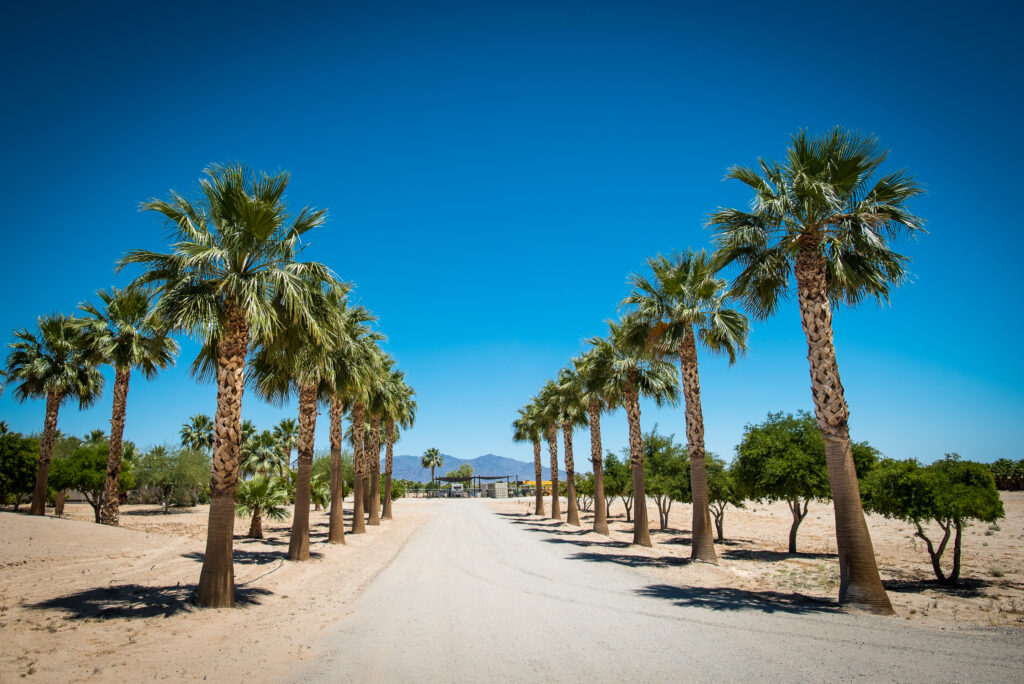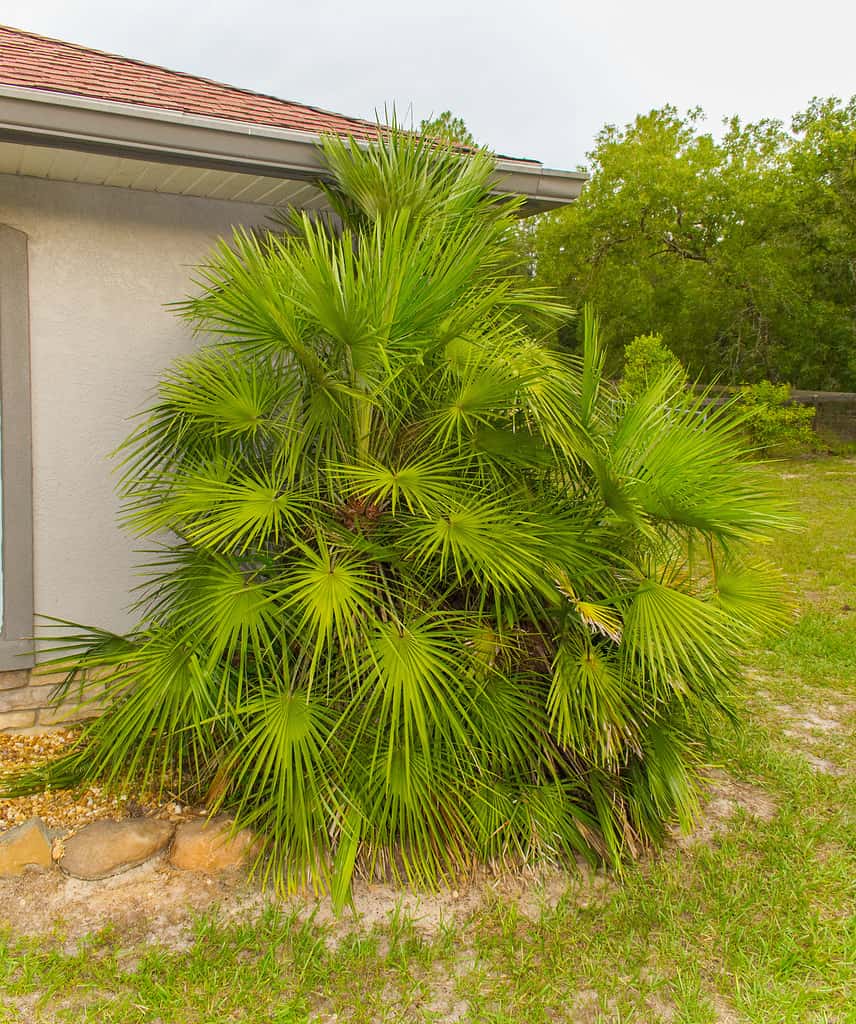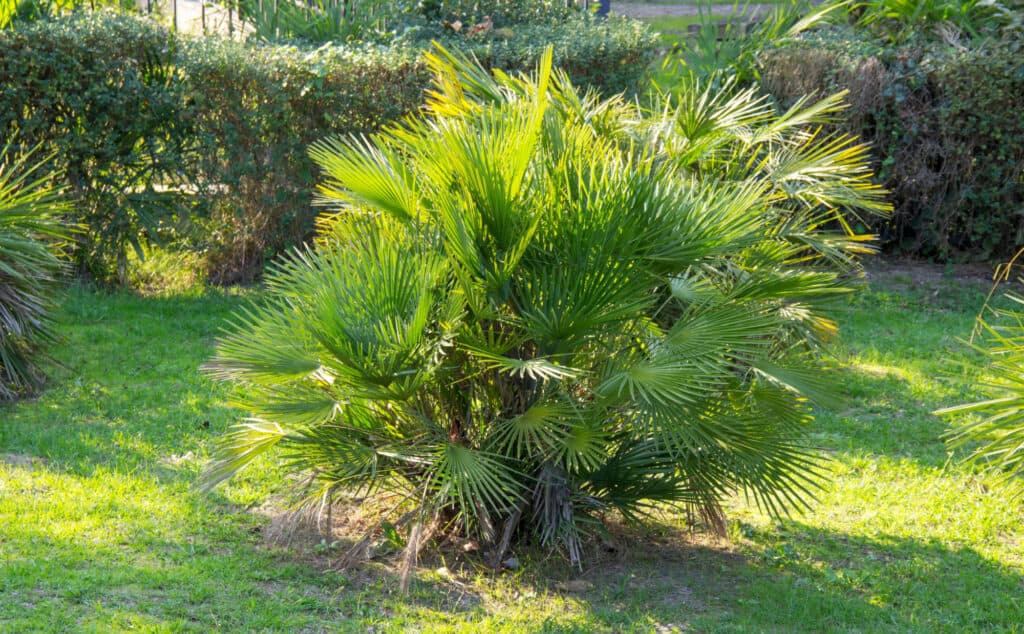No matter where in the world you live, you are almost assuredly able to grow a fan palm tree in your climate. Far from being just tropical trees, fan palms have adapted to grow in a wide range of environments and can even grow indoors!
In this guide, we’ll talk about how fan palms are classified and how they grow, as well as list several interesting and varied species that you might want to try out for yourself. Then, to get you started, we’ll talk in greater depth about five of these species that each have very unique morphologies.
What Exactly Is a Fan Palm Tree?

Many palm trees, like Mexican fan palms, can tolerate cold weather.
©Papuchalka – kaelaimages/Shutterstock.com
Fan palms are not a single species of plant. The name refers to any of over 75 independent species of palms that span many genera. This group of plants is very diverse and its members originate from all across the globe.
From the high deserts of the western United States and Mexico to the Mediterranean, all the way to Asia, Africa, and the Pacific Islands, fan palms grow in a wide variety of climates. Because of this, they have all adopted different strategies for coping with their environments. Some, like the ruffled fan palm, are understory dwellers and thrive in moist, shaded soil beneath the forest canopy. Others, like the Mexican fan palm, grow to extreme heights in the full sun of seasonal desserts. They use their fibrous root structures to anchor themselves and can store water in their trunks for long periods.
While their morphologies can differ greatly, the primary feature that unites all of the plants that make this list is the shape of their leaves or fronds. Rather than pinnate palms that produce feather-like fronds, fan palms produce fronds that are palmate, or hand-shaped. Fan palm fronds may also be considered costapalmate, which means that they fall somewhere in between palmate and pinnate leaves in shape. These leaves, while still compound, tend to be less round overall and more oblong. Regardless of the technical terms, the fronds of fan palm trees are all, well, fan-like.
Can I Grow One at Home?

Plenty of species of fan palm trees are suited to home growing.
©iStock.com/Chase D’animulls
Because fan palms grow in such varied conditions and in such a wide range of climates, there is sure to be a fan palm to match your growing environment. Below, we’ve provided a list of 15 species of fan palm trees from across the world and included their botanical names to help you find accurate growing information for each one. Whether you’re looking for a gigantic, solitary shade palm, a multi-trunked border palm, or a small species to grow by a windowsill, the following list of species will give you a great starting point.
- Chinese windmill palm (Trachycarpus fortunei)
- Chinese fan palm (Livistona chinensis)
- Stone gate palm (Trachycarpus princeps)
- Mazari palm (Nannorrhops ritchiana) ¥
- Wagner palm (Trachycarpus wagnerianus)
- European fan palm (Chamaerops humilis)
- Bismarck palm (Bismarckia nobilis)
- Caranday palm (Trithrinax campestris)
- Ribbon palm (Livistona decipiens)
- Mexican blue palm/ blue hesper palm (Brahea armata)
- Ruffled fan palm (Licuala grandis)
- Blue rock palm (Brahea dulcis)
- Dwarf palmetto (Sabal minor)
- Lady palm (Rhapis excelsa)
- Bamboo palm (Chamaedorea seifrizii)
5 Most Popular Species of Fan Palm Tree
If their quantity is overwhelming, we’ve expanded below on five of the most iconic species of fan palm trees. You’ll find some key facts about the growth habits of each one, as well as the types of environments they prefer. Some can only really grow outdoors, while others can be containerized and brought inside as well. No matter where you are planting your fan palm, however, each one will give a unique, tropical feel to your space.
Bismarck Palm (Bismarckia nobilis)

Throughout a couple of decades, Bismarck palm trees can reach up to 60 feet high.
©NizamRahman83/Shutterstock.com
The Bismarck’s palm is a fast-growing and highly sought-after species of fan palm tree. It is used solely as a landscaping tree and is often planted singly to highlight its elegant and stately appearance. This approach gives them plenty of sunlight and all the space they need to spread out.
Trees of this species will, throughout a couple of decades, reach mature heights of around 60 feet with crowns that can spread as wide as 16 feet across. In the late spring and summer, females may produce long, brown inflorescences that give way to pendants of light green and brown fruit.
Aside from the impressive height, attractive trunk texture, and seasonal flowering, the real showstopping feature of this palm species is its fronds. Each frond is a beautiful gray-green or silvery blue color and can grow up to 10 feet long and 4 feet across. The crowns of these trees are altogether stunning and make a strong statement.
Mexican Fan Palm (Washingtonia robusta)

The Mexican fan palm is native to western Sonora and Baja California Sur in Mexico.
©iStock.com/SlavkoSereda
If you’ve got experience with palms and plenty of space to work with, the Mexican fan palm may be what you’re looking for. While this gigantic, fast-growing species may be too tall for most residential landscapes, its bushy, feather-duster canopy, and 70–100 foot height range are surely awe-inspiring. Healthy specimens of this species will produce a 360-degree canopy of fronds that can become 3–5 feet wide.
These titanic palms originate from the deserts of northern Mexico where rainwater appears infrequently throughout most of the year. It may surprise you, then, to learn that these palms prefer regular watering. In their natural environment, they grow nearby streams and river beds and at the edges of water sources. These areas supply a permanent source of water, either above ground or below when surface water dries up. Be sure to provide plenty of irrigation to help your palm look and feel its best.
Chinese Fan Palm (Livistona chinensis)

The Chinese palm has both male and female parts, and it self-fertilizes.
©topimages/Shutterstock.com
The fronds of the Chinese fan palm are the primary attraction for its use as a landscaping palm. At all stages of its life, it produces a crown of wide, densely compound fronds with trailing, ribbon-like tips. The cascading, fountain effect that is achieved when they catch a passing breeze is breathtaking.
While young palms of this species take a long time to form a trunk, they will eventually reach heights of around 40 feet and should ideally be grown outside. Additionally, the young fronds of this species are armed with spikes. When coupled with the wide spread of the canopy, planting this species in tight spaces can be a bad idea.
Outdoors, however, this palm species is versatile in its use. Before they develop trunks, several young palms can be planted in a row to provide privacy. Over many years, they will transition on their own into a shade-providing role.
European Fan Palm (Chamaerops humilis)

Compact and cold-hardy, the European fan palm is wildly popular.
©ToKa74/Shutterstock.com
The European fan palm tree is a slow-growing, low-maintenance palm that is perfect for indoor or outdoor planting. At maturity, these palms reach heights of between 5 and 10 feet. When grown in containers, they will usually top out around 6 feet tall. In either case, they will produce beautiful, curved trunks that may begin to form clusters with age.
Fronds of this palm species are light or pale green to silver in color and are delicately textured. They form arching crowns that may reach between 6 and 10 feet in diameter. While they are beautiful, however, this palm’s fronds are armed with sharp teeth — be careful with your placement!
In the spring and summer, European fan palms produce clusters of small, yellow flowers that eventually give way to fleshy, brown fruits of similar size.
It is very cold-hardy for a palm species, able to withstand winter temperatures in USDA zones as far north as zone 8. That means they can survive outdoors where temperatures may fall into the teens!
Vanuatu Fan Palm (Licuala grandis)

Another name for the Vanuatu fan palm is the ruffled fan palm.
©Aristsararas/Shutterstock.com
Also known as the ruffled fan palm, this species is native to the Pacific island country of its namesake. Like the European fan palm, this species is a beautiful but slow grower that will eventually reach heights of around 6 feet indoors. Outdoors, it can grow to about twice that size.
Each plant produces a single trunk and bears a crown of unique, pleated fronds that lend an exotic feel to any location. Because Vanuatu palms are native to the tropics, they are well-adapted to the temperature range of the average household. Likewise, because they grow in rainforest understories, they are perfectly adapted to low-light conditions. Direct sunlight can damage their sensitive fronds, so you need to plant them in a location that provides adequate shelter.
These palms require plenty of water throughout the year but will not do well in soils that are poorly draining. if you choose to grow this species, make certain that your landscape or choice of potting mix does not allow for standing water. Applying a layer of organic mulch will help to offset high drainage rates in the appropriate soils.
Thank you for reading! Have some feedback for us? Contact the AZ Animals editorial team.








